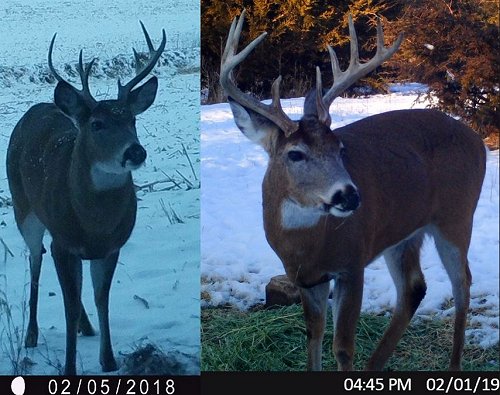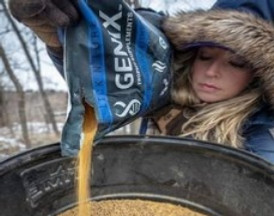Posted by Dan Carlson on Apr 9th 2020
Time to think about feeding deer
Deer season is behind us and turkey season arrives in a few weeks. Time between seasons is a good time to consider what can be done to improve the quality of game animals on your property. For deer, deployment of feeders and establishing a regular feeding schedule may be a good place to start.
Providing feed and mineral supplements to game animals is one of those things a landowner can do as much or as little of as personal ambition dictates. It can be as simply as placing mineral blocks out on the property or as ambitious as setting up feeders that time feed distribution over the course of days or weeks. To find out more about the hows and whys of deer feeding, I turned to an expert.
It’s fun to talk with someone who’s very good at something, very excited about doing it, and who clearly enjoys sharing their work. Kurt Nielsen of Genix Outdoors, LLC, is just such a person. He grew up on a farm working with livestock, an industry in which the search is always on for more efficient and effective ways of feeding animals. Kurt worked in a feed mill during his college years and was running such an operation not long thereafter. He’s also been bowhunting since he was 13 and knows a thing or two about deer hunting. I asked Kurt about scheduled feedings.
“Deer typically eat twice a day. Once in the morning and once in the evening or into the night,” he said. “Digestion requires energy. If you think of energy expenditure in a deer as a sine wave you have two peaks after each feeding, between which are low points or valleys. We developed a mix of feed that lowers the amplitude of those energy peaks and valleys so the animal doesn’t have such large metabolic swings. This is accomplished by providing the deer with optimal nutrients for digestion and distribution of needed vitamins and minerals throughout its system. The less energy a deer spends digesting and metabolizing food, the more energy is available for other things the animal must do, such as growing antlers.”
Kurt then told me he was monitoring a pair of 2-1/2-year-old bucks, one of which was estimated to score in the 170 class and the other more than 250, a degree of development not often seen until bucks are 3-4 years of age. He said that deer eating only what they find in the wild might see up to 20 inches of antler growth per year, but he has customers feeding Genix products to deer that have shown growth year-over-year more than twice that. This points to the role good nutrition from quality feed and minerals can have on antler growth.
Deer antler growth really begins to take off in May when winter storms are in the past, warm weather arrives and available moisture in both vegetation and water sources increases. Getting deer on supplemental feeds before this can jumpstart antler growth, improve overall animal health and ensure animals have adequate nutrition heading into summer.
“Antler growth in deer is going on at the fastest rate May through July,” Kurt explained. “During that time, antlers are less than 10-percent calcified. They’re quite flexible and, if you could see inside, they’re honeycombed. The growth process must have a good supply of nutrient-rich blood flowing into the antlers. Our feed dilates blood vessels that carry those nutrients to the antlers, ensuring consistent growth.”

Good nutrition does more than just grow antlers. It keeps does healthy as well, resulting in good milk production for fawns, lower fawn mortality and thereby increases the population of deer on or near your property.
Some people set out salt blocks. Kurt says these may attract deer but do little else for them. He says deer feed may contain some salt, but take care not to overdo it. Too much salt for deer, as is also the case for humans, can have negative consequences. Supplement dollars would be better spent on a quality mineral block containing other nutrients in addition to some salt.
Critics of feeding deer on private property cite two objections: feed contaminants and preference for a “natural” diet. As Kurt alluded to, the quality of natural browse is subject to the vicissitudes of weather. Too much or too little moisture, weather that’s too hot or too cold and extreme weather events such as severe storms, floods and drought can all impact the quality of natural food available on a property. Availability of quality feed can offset negative impacts from weather.
Contaminants in feed can sicken or weaken deer. It’s important to select high-quality feed and supplements free of animal byproducts and unnecessary fillers. Talk with landowners who put out feed and supplements to learn what experiences they’ve had with specific brands. It’s usually smart not to go the cheapest route, especially if cheap feeds are imported, but you don’t need to break the bank either. Look for feed companies that have a good reputation and have been around for a while. See if they’re willing to provide references and testimonials from customers. Contaminants can be a legitimate concern but are less so if you do some homework before buying feed.
Providing deer with quality feed and supplements year-round will tend to keep them in the area, improve their overall health and can even contribute to more deer on the property by keeping breeding does and fawns healthy. There are a variety of hanging and tripod feeders on the market to fit just about any budget. Do some research of your own and consider if setting out feed and supplements is something you’d like to do.

